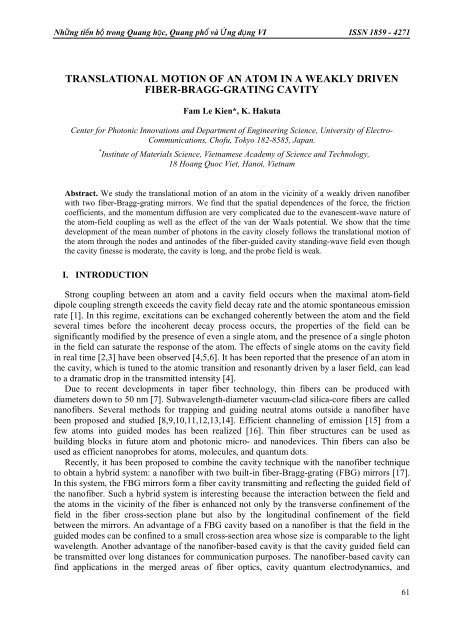Nhng tin b trong Quang hc, Quang ph và ng dng VI ISSN 1859 - 4271
Nhng tin b trong Quang hc, Quang ph và ng dng VI ISSN 1859 - 4271
Nhng tin b trong Quang hc, Quang ph và ng dng VI ISSN 1859 - 4271
Create successful ePaper yourself
Turn your PDF publications into a flip-book with our unique Google optimized e-Paper software.
Nhữ<strong>ng</strong> tiến bộ <stro<strong>ng</strong>>tro<strong>ng</strong></stro<strong>ng</strong>> <stro<strong>ng</strong>>Qua<strong>ng</strong></stro<strong>ng</strong>> học, <stro<strong>ng</strong>>Qua<strong>ng</strong></stro<strong>ng</strong>> <stro<strong>ng</strong>>ph</stro<strong>ng</strong>>ổ và Ứ<strong>ng</strong> dụ<strong>ng</strong> <strong>VI</strong> <strong>ISSN</strong> <strong>1859</strong> - <strong>4271</strong>TRANSLATIONAL MOTION OF AN ATOM IN A WEAKLY DRIVENFIBER-BRAGG-GRATING CA<strong>VI</strong>TYFam Le Kien*, K. HakutaCenter for Photonic Innovations and Department of E<strong>ng</strong>ineeri<strong>ng</strong> Science, University of Electro-Communications, Chofu, Tokyo 182-8585, Japan.* Institute of Materials Science, Vietnamese Academy of Science and Technology,18 Hoa<strong>ng</strong> Quoc Viet, Hanoi, VietnamAbstract. We study the translational motion of an atom in the vicinity of a weakly driven nanofiberwith two fiber-Bragg-gra<s<stro<strong>ng</strong>>tro<strong>ng</strong></stro<strong>ng</strong>>>tin</s<stro<strong>ng</strong>>tro<strong>ng</strong></stro<strong>ng</strong>>>g mirrors. We find that the spatial dependences of the force, the frictioncoefficients, and the momentum diffusion are very complicated due to the evanescent-wave nature ofthe atom-field coupli<strong>ng</strong> as well as the effect of the van der Waals potential. We show that the timedevelopment of the mean number of <stro<strong>ng</strong>>ph</stro<strong>ng</strong>>otons in the cavity closely follows the translational motion ofthe atom through the nodes and an<s<stro<strong>ng</strong>>tro<strong>ng</strong></stro<strong>ng</strong>>>tin</s<stro<strong>ng</strong>>tro<strong>ng</strong></stro<strong>ng</strong>>>odes of the fiber-guided cavity standi<strong>ng</strong>-wave field even thoughthe cavity finesse is moderate, the cavity is lo<strong>ng</strong>, and the probe field is weak.I. INTRODUCTIONS<stro<strong>ng</strong>>tro<strong>ng</strong></stro<strong>ng</strong>> coupli<strong>ng</strong> between an atom and a cavity field occurs when the maximal atom-fielddipole coupli<strong>ng</strong> stre<strong>ng</strong>th exceeds the cavity field decay rate and the atomic spontaneous emissionrate [1]. In this regime, excitations can be excha<strong>ng</strong>ed coherently between the atom and the fieldseveral times before the incoherent decay process occurs, the properties of the field can besignificantly modified by the presence of even a si<strong>ng</strong>le atom, and the presence of a si<strong>ng</strong>le <stro<strong>ng</strong>>ph</stro<strong>ng</strong>>otonin the field can saturate the response of the atom. The effects of si<strong>ng</strong>le atoms on the cavity fieldin real time [2,3] have been observed [4,5,6]. It has been reported that the presence of an atom inthe cavity, which is tuned to the atomic transition and resonantly driven by a laser field, can leadto a dramatic drop in the transmitted intensity [4].Due to recent developments in taper fiber technology, thin fibers can be produced withdiameters down to 50 nm [7]. Subwavele<strong>ng</strong>th-diameter vacuum-clad silica-core fibers are callednanofibers. Several methods for trappi<strong>ng</strong> and guidi<strong>ng</strong> neutral atoms outside a nanofiber havebeen proposed and studied [8,9,10,11,12,13,14]. Efficient channeli<strong>ng</strong> of emission [15] from afew atoms into guided modes has been realized [16]. Thin fiber structures can be used asbuildi<strong>ng</strong> blocks in future atom and <stro<strong>ng</strong>>ph</stro<strong>ng</strong>>otonic micro- and nanodevices. Thin fibers can also beused as efficient nanoprobes for atoms, molecules, and quantum dots.Recently, it has been proposed to combine the cavity technique with the nanofiber techniqueto obtain a hybrid system: a nanofiber with two built-in fiber-Bragg-gra<s<stro<strong>ng</strong>>tro<strong>ng</strong></stro<strong>ng</strong>>>tin</s<stro<strong>ng</strong>>tro<strong>ng</strong></stro<strong>ng</strong>>>g (FBG) mirrors [17].In this system, the FBG mirrors form a fiber cavity transmit<s<stro<strong>ng</strong>>tro<strong>ng</strong></stro<strong>ng</strong>>>tin</s<stro<strong>ng</strong>>tro<strong>ng</strong></stro<strong>ng</strong>>>g and reflec<s<stro<strong>ng</strong>>tro<strong>ng</strong></stro<strong>ng</strong>>>tin</s<stro<strong>ng</strong>>tro<strong>ng</strong></stro<strong>ng</strong>>>g the guided field ofthe nanofiber. Such a hybrid system is interes<s<stro<strong>ng</strong>>tro<strong>ng</strong></stro<strong>ng</strong>>>tin</s<stro<strong>ng</strong>>tro<strong>ng</strong></stro<strong>ng</strong>>>g because the interaction between the field andthe atoms in the vicinity of the fiber is enhanced not only by the transverse confinement of thefield in the fiber cross-section plane but also by the lo<strong>ng</strong>itudinal confinement of the fieldbetween the mirrors. An advantage of a FBG cavity based on a nanofiber is that the field in theguided modes can be confined to a small cross-section area whose size is comparable to the lightwavele<strong>ng</strong>th. Another advantage of the nanofiber-based cavity is that the cavity guided field canbe transmitted over lo<strong>ng</strong> distances for communication purposes. The nanofiber-based cavity canfind applications in the merged areas of fiber optics, cavity quantum electrodynamics, and61















